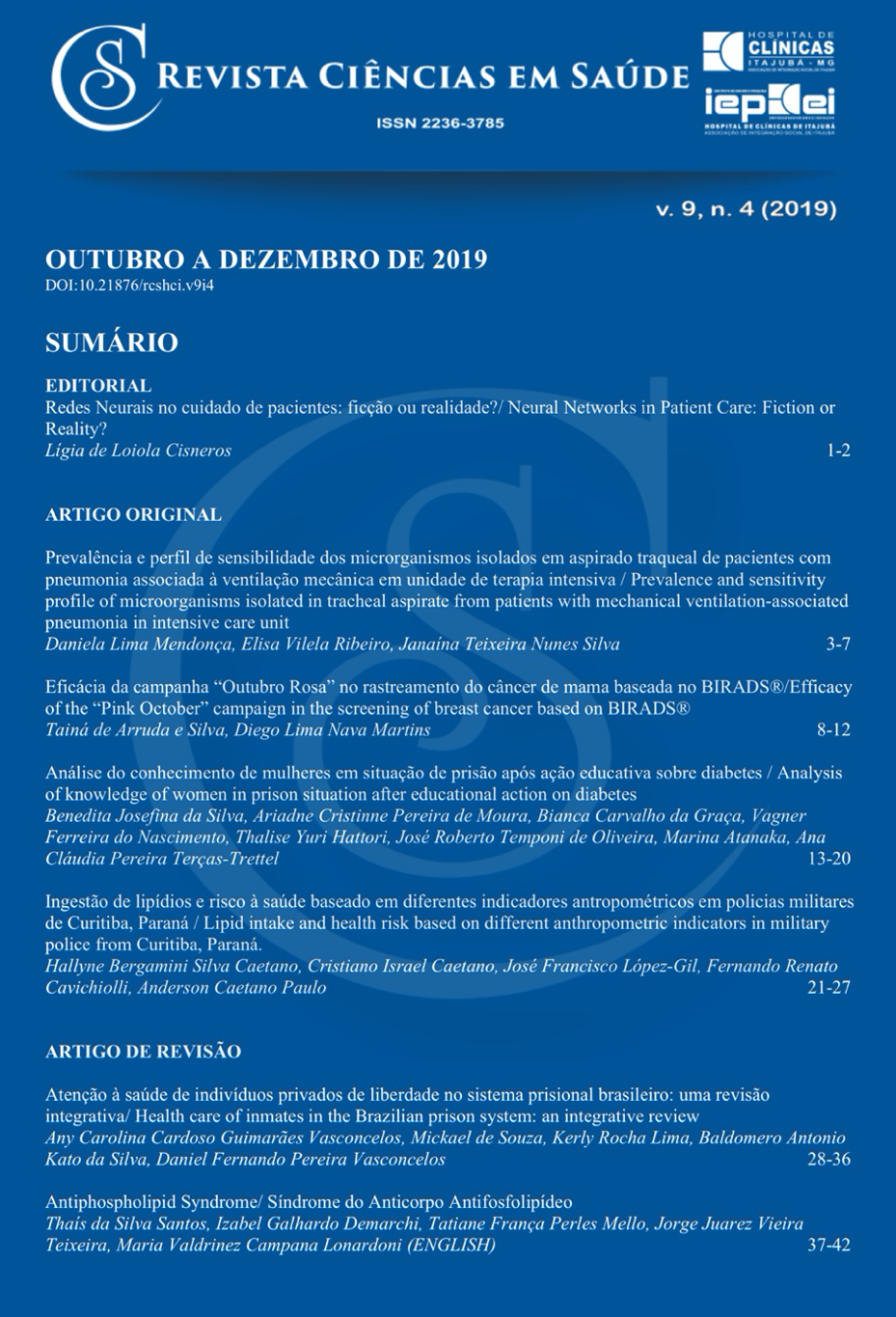Prevalence and sensitivity profile of microorganisms isolated in tracheal aspirate from patients with mechanical ventilation-associated pneumonia in intensive care unit
Main Article Content
Abstract
Objective: To analyze the prevalence and sensitivity profile of microorganisms isolated from tracheal secretion in patients with mechanical ventilation-associated pneumonia (VAP) in an intensive care unit, in order to outline the epidemiological profile and guide empirical therapy. Methods: A cross-sectional prevalence study was conducted by collecting data from medical records of patients admitted to the ICU of Santa Casa de Misericordia de São João del-Rei in 2016. Initially, patients with positive tracheal secretion culture were selected and later identified those that fit the diagnosis of VAP, according to the criteria of the National Health Surveillance Agency. Results: Pseudomonas aeruginosa was the most commonly isolated bacterium, representing 40%, followed by S. aureus, Acinetobacter baumanni and Klebsiella sp (13% each). Proteus mirabilis, Enterobacter sp and Burkholderia cepacia accounted for 6.7% each. P. aeruginosa showed some resistance to ceftazidime (33%) and little resistance to cefepime, levofloxacin, ciprofloxacin and meropenem (16%). Conclusion: It was observed a high prevalence of gram-negative bacteria in ICU VAPs and high levels of antimicrobial resistance. Further studies are needed to follow this resistance profile, as it is a pattern that may vary over time.
Article Details
Authors maintain copyright and grant the HSJ the right to first publication. From 2024, the publications wiil be licensed under Attribution 4.0 International 
 , allowing their sharing, recognizing the authorship and initial publication in this journal.
, allowing their sharing, recognizing the authorship and initial publication in this journal.
Authors are authorized to assume additional contracts separately for the non-exclusive distribution of the version of the work published in this journal (e.g., publishing in an institutional repository or as a book chapter), with acknowledgment of authorship and initial publication in this journal.
Authors are encouraged to publish and distribute their work online (e.g., in institutional repositories or on their personal page) at any point after the editorial process.
Also, the AUTHOR is informed and consents that the HSJ can incorporate his article into existing or future scientific databases and indexers, under the conditions defined by the latter at all times, which will involve, at least, the possibility that the holders of these databases can perform the following actions on the article.
References
Agência Nacional de Vigilância Sanitária. Medidas de Prevenção de Infecção Relacionadas à Assistência à Saude. [Internet]. 2017. [cited 2019 Nov 27]. Avaiable from: http://portal.anvisa.gov.br/documents/33852/3507912/Caderno+2+-+Critérios+Diagnósticos+de+Infecção+Relacionada+à+Assistência+à+Saúde/7485b45a-074f-4b34-8868-61f1e5724501
Prade SS, Felix J, Mendes A, Gadelha MZ, Pereira M. Estudo brasileiro da magnitude das infecções hospitalares em hospitais terciários. Rev Controle de Infecção Hospitalar. 1995;2:11-24.
Guimarães M, Rocco J. Prevalência e prognóstico dos pacientes com pneumonia associada a ventilação mecânica em um hospital Universitário. J. Bras. Pneumol. 2006;32(4):339-46. doi: 10.1590/S1806-37132006000400013
Rello J, Ausina V, Ricart M, Castella J, Pratis G. Impact of previous antimicrobial therapy on the etiology and outcome of ventilator-associate pneumonia. Chest. 1993;104(4):1230-5. doi: 10.1378/chest.104.4.1230
Frota ML, Campanharo CRV, Lopes MCBT, Piacezzi LHV, Okuno MFP, Batista REA, et al. Boas práticas para prevenção de pneumonia associada à ventilação mecânica no serviço de emergência. Rev Esc Enferm USP. 2019;53:e0460. doi: 10.1590/s1980-220x2018010803460
Carvalho MVCF, Winkeler GFP, Costa FAM, Bandeira TJG, Pereira EDB, Holanda MA. Concordância entre o aspirado traqueal e o lavado broncoalveolar no diagnóstico das pneumonias associadas à ventilação mecânica. J Bras Pneumol. 2004;30(1):26-38. doi: 10.1590/S1806-37132004000100007.
Lee MS, Walker V, Chen LF, Sexton DJ, Anderson DJ. The epidemiology of ventilator-associated pneumonia in a network of community hospitals: a prospective mulicenter study. Infect Control Hosp Epidemiol. 2013;34(7):657-62. doi: 10.1086/670991
Teixeira PJZ, Hertz FT, Cruz DB, Caraver F, Hallal RC, Moreira JS. Pneumonia associada à ventilação mecânica: impacto da multirresistência bacteriana na morbidade e moralidade. J Bras Pneumol. 2004;30(6): 540-48. doi: 10.1590/S1806-37132004000600009
Neto EC, Souza PC, Azevedo F, Lugarinho MF. Pneumonia associada à ventilação mecânica: análise de fatores epidemiológicos na confecção de estratégias de profilaxia e terapêutica. Rev Bras Ter Intensiva. 2006;18(4):344-50. doi: 10.1590/S0103-507X2006000400005
Larrondo Muguercia HM. Infección por bacilos gram-negativos no fermentadores. Problematica en las unidades de cuidados intensivos. Rev Haban Cienc Med [Internet]. 2010 [cited 2019 Nov 28]; 9(Supl 5):680-7. Avaiable from: http://scielo.sld.cu/scielo.php?script=sci_arttext&pid=S1729-519X2010000500011&lng=es&tlng=es
Rodrigues PMA, Neto E C, Sanos LRC, Knibel MF. Pneumonia associada à ventilação mecânica: epidemiologia e impacto na evolução clínica de pacientes em uma unidade de terapia intensiva. J Bras Pneumol. 2009;35(11):1084-91. doi: 10.1590/S1806-37132009001100005
Medell M, Hart M, Duquesne A, Espinosa F, Valdés F. Nosocomial ventilator-associated pneumonia in Cuban intensive care units: bacterial species and antibiotic resistance. MEDICC Review [Internet]. 2013 [cited 2019 Nov 28];15(2):26-9. Avaiable from: http://mediccreview.org/wp-content/uploads/2018/04/mr_301.pdf

